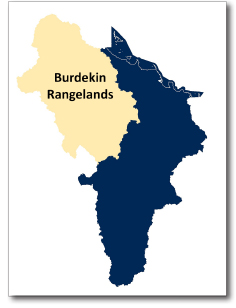
“NRM involves us all. With our variable climate, every drop of water counts in making our soils productive for all plants and animals. We will work together to face pest and weed issues and share our knowledge about how healthy country can support a resilient and productive community.”
Country
The Burdekin Rangelands sub-region is bound by mountains, and a large proportion of the area consists of strongly undulating terrain. To the west, the basalt plateaus of the Great Dividing Range rise to over 900m. The crest of the eastern ranges near Paluma supports rainforest and includes the southern extent of the Wet Tropics World Heritage Area.
This sub-region features a small area of the Einasleigh Upland bioregion in the north, the Northern Brigalow bioregion in the centre, and the Desert Uplands bioregion in the south-west. Vegetation includes acacia open forest and eucalypt woodland. The Dalrymple, White Mountains and Great Basalt Wall national parks are found in the rangelands, along with nationally important wetlands including Lake Dalrymple. The lake is formed by the Burdekin Falls Dam on the Burdekin River, the largest dam in Queensland. The river and dam are popular destinations for fishing and bird watching.
Community and enterprise
Charters Towers is the main urban centre in the Burdekin Rangelands. Established in 1867 and boosted by the discovery of gold, the current population of around 12,500 is supported by the mining and beef industries. Mining is a significant employer, however the majority of land is used for beef production on natural grasslands. Charters Towers sources its water from the Charters Towers Weir, and the town is an education centre, with boarding schools catering for remote rural families. It has many heritage buildings which, together with national parks, provide outback tourism opportunities.
There have been calls from landholders and the Charters Towers Regional Council to expand irrigated agriculture in this sub-region, however this would require a secure and sustainable supply of water, careful consideration of land suitability and impacts on downstream systems.
Burdekin Rangelands Community Priorities
Community and industry resilience
“We most value our people, because landholders are key to good land and NRM. Succession planning is important to attract energetic and enthusiastic young people, along with schemes that address social isolation and promote a better understanding between city and country dwellers. A stable community is a good environment in which to do business, and enterprises need diverse talents to ‘ride out’ market and climate variability. We will work with extension and education providers to take up new technology and explore business skills and diversification options.”
Sustainable land use
“Our community would like to protect our land, which is a source of cultural identity and an inspiration for current and potential new enterprises, including tourism. We will continue to support property management, which integrates actions to look after soils, water, vegetation, weeds and feral animals, with agricultural best practice and business sustainability. We will strive to achieve good soil biodiversity, which benefits pasture, captures moisture and carbon, and prevents erosion.”
Efficient research investment and collaborative decision-making
“Good quality research is shared with landholders as it is essential to help properties become more resilient by diversifying and developing new commercial markets. Our community wants to encourage investment in our area for emerging industries, such as using woody weeds as a resource, feedlots, camels and new crops. To achieve this, we will work with State and local governments to influence decisions about land development and regulation that impact on business profitability. We would like to encourage banks to be more flexible, and reduce red-tape for enterprises that can demonstrate planning for long-term sustainability.”
